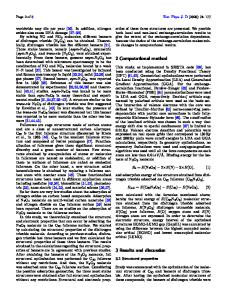Adsorption Behavior of Aromasin onto C 20 and C 24 Nano-Cages: Density Functional Theory Study
- PDF / 1,272,126 Bytes
- 6 Pages / 612 x 792 pts (letter) Page_size
- 8 Downloads / 434 Views
HEORETICAL INORGANIC CHEMISTRY
Adsorption Behavior of Aromasin onto C20 and C24 Nano-Cages: Density Functional Theory Study Mahboobeh Kiana and Elham Tazikeh-Lemeskia, * aDepartment
of Chemistry, Gorgan Branch, Islamic Azad University, Gorgan, Iran *e-mail: [email protected]
Received May 18, 2020; revised June 22, 2020; accepted July 3, 2020
Abstract—Nano-cage based materials are nowadays broadly investigated due to their potential applications as biosensors and drug delivery systems. In the current study, we evaluated the adsorption behavior of Aromasin (AMS) drug on C20 and C24 nano-cages at the PBE/6-311G** level of theory. AMS drug can be adsorbed on the C20 and C24 nano-cages generally via their C=O and C–H groups. The physisorption of AMS drug from its C=O group onto C20 and C24 nano-cages is the most stable in comparison with the C–H group. The electronic and structural properties of the C20 in comparison with C24 can be enhanced when AMS drug adsorbed on it. The AMS adsorption onto the C20 changes the polarity of the pure nano-cage as displayed by the calculated dipole moment values. Our results suggest that C20 may be used for drug delivery systems. Keywords: aromasin (AMS), C20 and C24 nano-cages, electronic and structural properties DOI: 10.1134/S0036023620120074
INTRODUCTION Aromasin (AMS), (6-methylideneandrosta-1,4diene-3,17-dione) is an effective anticancer drug widely used to treat breast cancer in postmenopausal women [1, 2]. The use of this drug because of high hydrophobicity (logP4.222), poor water solubility (0.08 mg/ml), and side effects limit its therapeutic result for clinical application [2]. To overcome these adverse effects, the use of several nanostructures as drug carriers has been on the rise [3, 4]. Nano formulation of drugs, nucleic acid ligands, and bioactive molecules have been extensively used in recent years for drug and gene delivery [5–8]. Despite considerable structural differences, soft materials (such as liposomes, micelles, and niosome) [9–11], carbon nanostructures [12, 13], and metal nanoparticles [12] both have been efficient carriers and complementary approach in drug delivery and theranostics applications which potentially can be applied for minimizing undesired burst effects and achieving constant drug release rates at the site of action [13]. The purpose of this study is the evaluation of the adsorption behavior of AMS drug onto the carbon fullerene-like cage to minimize toxic side effects of the drug with a high dose and anticancer activity. After synthesis of carbon fullerene-like cages [14], they attracted remarkable attention in different scientific areas because of their chemical and physical features [15]. Carbon fullerenelike cages such as C60, C24, and C20 in the spherical forms are known as buckminsterfullerene or buckyball that can be used for solving some of the emerging chal-
lenges, including hydrogen storage, biosensor, environmental pollution, and biomedical applications [16–20]. There are theoretical and experimental studies where they
Data Loading...










